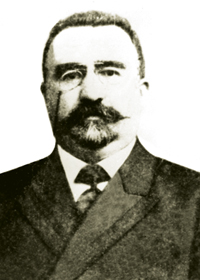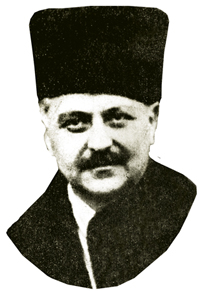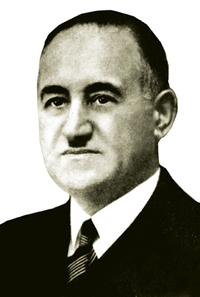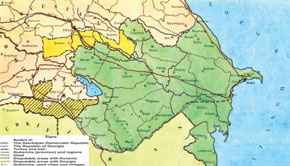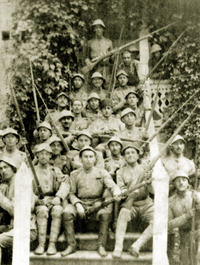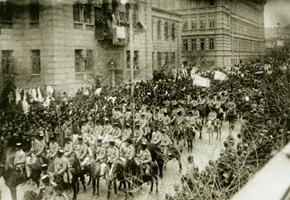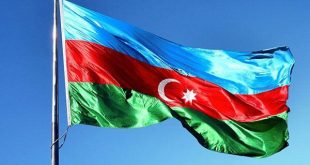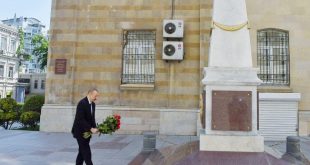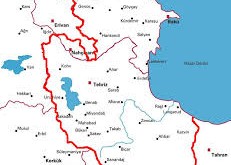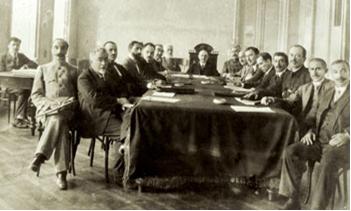
DECLARATION OF INDEPENDENCE
After Azerbaijan was divided between the Russian and Persian Empires in 1813 and 1828, the subsequent period saw the development of enlightenment and national consciousness, the national movement, begun by intellectuals, and the path to state independence. None of this
TERRITORY AND BOUNDARIES
The territory of the Azerbaijan Democratic Republic is spoken about for the first time in the Declaration of Independence. The document says that Azerbaijan, located in the south and east Trans-Caucasus, is an independent state. The memorandum, submitted by the Azerbaijani delegation to the Paris Peace Conference in
November 1918, sets out the territory of the republic as follows: Baku Province (Baku district, Javad district, Goychay district, Shamakhi district, Quba district, Lankaran district together with the Baku Circle); Yelizavetpol (Ganja) Province (Ganja district, Javanshir district, Nukha district, Arash district, Shusha district, Karyagi [Jabrayil] district, Zangezur district, Qazakh district [one-third of these territories which consisted of mountainous areas, were disputed between Azerbaijan and Armenia]); Irevan Province (Nakhchivan district, Sharur-Daralayaz district, Surmeli district, New Bayazid district, a part of Echmiadzin and Alexandropol districts); Tbilisi Province (Borchali district, a part of Tbilisi and Signakh districts); Zagatala region, Dagestan Province (a part of the Kur and Samur areas, also Derbent city and its suburbs together with part of Gaytar-Tabasaran Province). The borders in the north were determined by the River Samur and the Greater Caucasus range. The border with Georgia in the west was the same as the present borders of the Republic of Azerbaijan. The only discrepancy was the boundary between Borchali and Qazakh regions; this passed through Poylu. The border with Armenia went down to Goycha Lake in the south and, passing through the middle of the lake, went as far as the Turkish border, west of Bash Norashen, including Bazarkecher and Zangezur.
Only 8,700 km2 of the land where Azerbaijanis were living was disputed (Borchali, Garayazi and Signakh districts). The corresponding areas (7,900 km2) of Irevan, Echmiadzin, Surmeli and New Bayazid districts, which were subordinate to Armenia, were disputed by the government of Azerbaijan.
The territory of the republic was 113,900 km2 of which 97,300 thousand km2 were undisputed and 16,600 km2 disputed. The present territory of Azerbaijan is 86,600 km2.
POPULATION
The document submitted to the Paris Peace Conference by the government of Azerbaijan showed that the population of the South Caucasus was 8,081,668 of which 4,617,671 lived in Azerbaijan. A total of 75.4 per cent, or 3,481,889 of the Azerbaijani population, were Azerbaijanis. The other ethnic groups had appeared as the result of the resettlement policies of Tsarism in different periods of history. Overall, 43.1 per cent of the population in the South Caucasus was Muslim.
AZERBAIJAN PARLIAMENT
The Azerbaijan Democratic Republic was the first parliamentary republic in the east. The law on the formation of the Azerbaijan Parliament was adopted on 19 November 1918. The National Council, which consisted of 44 Azerbaijanis, stopped its work in Ganja on 17 June 1918 and resumed work under the chairmanship of Mammed Emin Rasulzadeh. The National Council decided to form a Parliament of 120 people. The Parliament was to consist of 80 Azerbaijanis and representatives of other nations according to their proportion in the population. But the Armenians and others, who did not want the independence of Azerbaijan, did not participate in the activity of the Parliament. The last assembly of the Parliament was held on 27 April 1920. The Parliament held 155 meetings, ten of them while the National Council was still operating from 27 May to 19 November 1918, and the other 145 from 7 December 1918 till 27 April 1920. The Parliament discussed more than 270 draft laws, 230 of which were adopted. There were 11 factions in Parliament. The chairman of Parliament was Alimardan bey Topchubashov, and his deputies were Hasan bey Agayev and Mammadyusif Jafarov.
AZERBAIJAN GOVERNMENT
Executive power was held by the government in Azerbaijan. The first prime minister was Fatali khan Khoyski. The government was based in Tbilisi from 28 May to 16 June 1918, in Ganja from 16 June to 17 September 1918 and in Baku from 17 September 1918 to 28 April 1920. The head of the first, second and third cabinets was Fatali khan Khoyski, and of the fourth and fifth cabinets was Nasib bey Yusifbeyli.
INTERNAL POLICY
The government conducted an active domestic policy. The National Army was created in a short time. Azerbaijani was declared the state language and special attention was paid to culture. Baku State University was founded, schools, libraries and clubs were opened and a number of newspapers were published.
FOREIGN POLICY
The main aim of the foreign policy of the Azerbaijan Democratic Republic was the promoting of the newly established state. The new government, therefore, conducted an active foreign policy from its inception. Information was sent to a number of European countries about the establishment of the new state. The government signed a friendship treaty with the Ottoman Empire in Batumi. The first step in foreign policy was to send a delegation, consisting of Mammad Emin Rasulzadeh and Aslan Saikurdski, to the Istanbul Conference, which was intended to be held between the Allied Powers (or the Entente Powers. The main allies were the French Third Republic, Imperial Russia, the British Empire, Italy and the United States.) and the South Caucasus republics. Alimardan bey Topchubashov was sent to Istanbul to create diplomatic relations with European countries.
After Central Powers (Germany, Austria-Hungary, the Ottoman Empire, and Bulgaria) were defeated in World War I, the Allies’ army came to Baku, led by Gen W.M. Thomson, on 17 November 1918. Despite the activity of the Armenian and Russian national councils against Azerbaijan, once Gen Thomson had familiarized himself with the situation, he declared that he respected highly the government of Azerbaijan and its prime minister and that its government would be the only legal power in the country until the formation of the new coalition government.
One of the first steps of Azerbaijan was to determine the makeup of the delegation to the Paris Peace Conference. The delegation, led by Alimardan bey Topchubashov, left for Paris after holding a number of meetings with the representatives of different countries in Istanbul. The Azerbaijan issue was discussed at the Council of Allied Powers on 2 May 1919 for the first time. The delegation of Azerbaijan held several meetings. On 23 May a member of the British delegation, L. Mallet, met Topchubashov and they discussed political, military and economic issues. On 28 May Topchubashov met a member of the US delegation, Henry Morgenthau, during the first half of the day and President Woodrow Wilson during the second half. The memorandum of Azerbaijan was presented to the president of the USA. The government of the USA noted that cooperation with Azerbaijan would be effective.
In late June the British government adopted a decision on the withdrawal of troops from Azerbaijan. It was not possible to implement the Italian mandate in Azerbaijan in place of the British one. At the suggestion of the British foreign secretary, Lord Curzon, the independence of Azerbaijan was known de-facto in the assembly of the Supreme Council of the Paris Peace Conference on 11 January 1920. Following this, some countries opened their representative offices in Baku and some established diplomatic relations with Azerbaijan.
But, taking advantage of the international situation, Bolshevik Russia occupied Azerbaijan and put an end to its independence. The Azerbaijan Republic was substituted with Soviet Azerbaijan after 23 months of existence.
DECLARATION OF INDEPENDENCE
The type of government of the independent state of Azerbaijan is a democratic republic. The Azerbaijan Democratic Republic intends to establish friendly relations with all nations, especially with the neighbouring nations and states.
The Azerbaijan Democratic Republic ensures all citizens living within its borders full civil and political rights, regardless of ethnic origin, religion, class, profession or gender. The Azerbaijan Democratic Republic creates broad opportuni ties for the independent development of all nationalities living in its territory.
Until the Constituent Assembly is convened, the supreme authority in Azerbaijan is vested in the National Council, elect ed by the Azerbaijani nation, and the provisional government, which is responsible to the National Council.
By: Professor Musa Qasimly
 Oval Useful news from Azerbaijan and Caucasus
Oval Useful news from Azerbaijan and Caucasus
